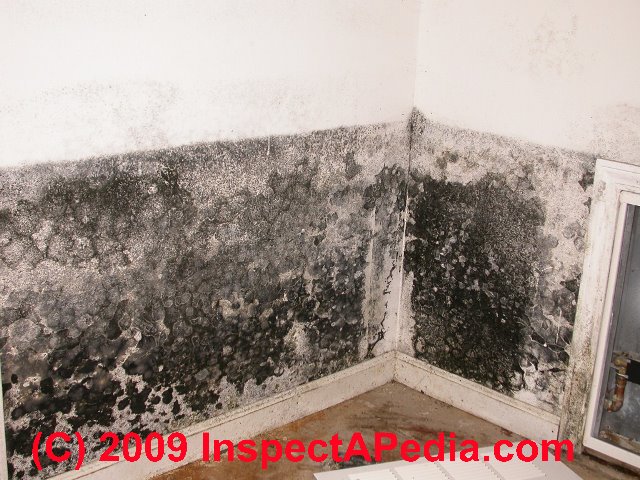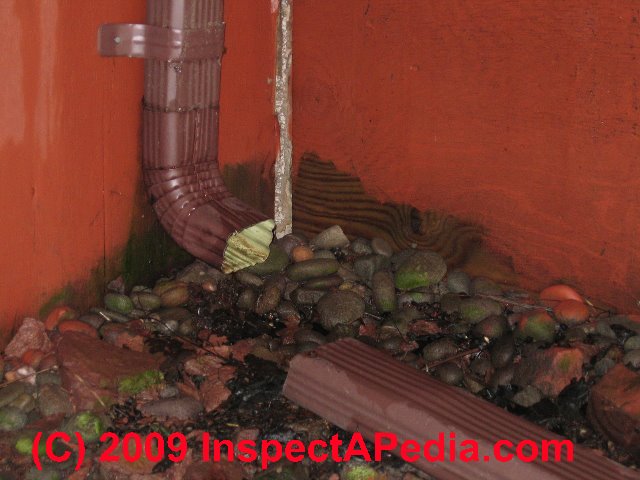 Failure to Prevent Future Mold Growth
Failure to Prevent Future Mold Growth
Mold Remediation Mistakes to Avoid
- POST a QUESTION or COMMENT about using ozone to kill mold in buildings or vehicles
Mold remediation mistakes: failure to fix the cause of mold growth.
Here we list articles that give key steps to prevent new mold growth after a mold cleanup project.
Even the best mold cleanup job cannot guarantee against a completely new mold contamination problem in a building, but if the work plan includes identifying the cause of the current mold problem and if that cause is corrected the job will have been correctly performed - we prevent future mold growth.
InspectAPedia tolerates no conflicts of interest. We have no relationship with advertisers, products, or services discussed at this website.
- Daniel Friedman, Publisher/Editor/Author - See WHO ARE WE?
Failure to Prevent future mold growth wastes mold cleanup dollars
 Find and fix the cause of mold:
Find and fix the cause of mold:
A really troubling mistake that we find on occasion is that someone has spent a lot on mold cleanup but no one bothered to identify the reason why mold grew in the building in the first place.
It is not possible to successfully complete a mold remediation project if the causes of mold growth have not been found and corrected. Otherwise, in as little as 24-48 hours mold may appear all over again.
Photo: the downspout spilling roof runoff right by the crawl space behind the wood framed plywood crawlspace skirt in this photo is likely to create new wet conditions in the crawl space that had just been cleaned and sealed - shown in in more detail
at INCOMPLETE MOLD CLEANUP where we also illustrate a good job of moldy crawl space cleanup.
Key Steps in Preventing a Return of Mold Problems After a Mold Cleanup Project
Prevention of water leaks or excess humidity in building interiors, including wall and floor cavities, is critical if you want to avoid a mold growth problem in a building.
Even following the most thorough mold remediation, future roof, plumbing, or cooling condensate leaks or any other source of water entry all risk future mold growth and related cosmetic, structural, health problems and economic costs.
To prevent problem indoor mold your focus should be on watching for and correcting leaks or moisture problems in your building.
For details on how to prevent indoor mold growth in buildings see these articles.
- CRAWL SPACE DRYOUT - how to get a wet crawl space dry and how to keep it dry
- FAILURE TO PREVENT FUTURE MOLD - this article lists mistakes that you'll want to avoid
- FLOOD DAMAGE REPAIR PRIORITIES - these quick steps after a building flood or plumbing leak can prevent costly mold contamination
- FLOOD-CAUSED MOLD, PREVENTION
- FUNGICIDAL SEALANT USE GUIDE - there is a place for these treatments but not as a substitute for proper cleaning steps
- HUMIDITY CONTROL & TARGETS INDOORS what indoor humidity should we maintain in order to avoid a mold problem?
- INADEQUATE REMEDIATION PLAN - if mold cleanup job is not done correctly you will probably have a mold problem immediately after the contractor leaves your driveway, either because the contractor left significant levels of moldy materials that should have been removed, moldy surfaces that should be cleaned, or leaks that must be repaired to prevent a rapid reappearance of mold growth in the building.
Cross contamination of mold into other building areas can also result from an inadequate mold remediation plan that does not include proper dust and debris containment.
See MOLD CLEANUP AREA CROSS CONTAMINATION - INEFFECTIVE MOLD PRODUCTS that can cause unnecessary expense or that are ineffective in treating or preventing mold contamination
- MOLD PREVENTION GUIDE - home: Correct the Causes of Mold and Prevent Indoor Mold or other indoor environment problems
- MOLD PREVENTION: Avoiding Mold Problems in Buildings by Using Mold-resistant Construction Products & Practices
- MOLD RESISTANT CONSTRUCTION - construction practices to mold-proof a building
- Mold Action Guide after Flooding: How to Minimize Mold Damage After a Building Flood
- How to Prevent Mold: how to avoid mold growth in buildings: priorities, repairs, products
- HUMIDITY CONTROL & TARGETS INDOORS: How Low Should You Keep Indoor Humidity to Avoid a Mold Problem
- IAQ or ANTI-MOLD PRODUCTS - may be helpful
- MOLD PRODUCTS, INEFFECTIVE - after-flood "anti-mold" procedures that do not work or are unsafe - to help you avoid unnecessary expense in dealing with mold after a building flood.
- MOLD PROOF DRYWALL - really?
- MOLD RESISTANT CONSTRUCTION some detailed suggestions from an expert on preventing mold growth indoors
- Ozone Warnings - Use of Ozone as a "mold" remedy is ineffective and may be dangerous.
- PRIORITIES for PREVENTING INDOOR MOLDContamination in Buildings - responding to leaks and floods
- Meruliporia incrassata - "Poria" the house eating fungus Meruliporia incrassata or perhaps a different mold, Serpula lacrymans - which one is the "house eating fungus" - what it house rotting mold like in a building and under the microscope
...
Continue reading at INADEQUATE MOLD REMEDIATION PLAN or select a topic from the closely-related articles below, or see the complete ARTICLE INDEX.
Or see these
Recommended Articles
Suggested citation for this web page
FAILURE TO PREVENT FUTURE MOLD at InspectApedia.com - online encyclopedia of building & environmental inspection, testing, diagnosis, repair, & problem prevention advice.
Or see this
INDEX to RELATED ARTICLES: ARTICLE INDEX to MOLD CONTAMINATION & REMEDIATION
Or use the SEARCH BOX found below to Ask a Question or Search InspectApedia
Ask a Question or Search InspectApedia
Try the search box just below, or if you prefer, post a question or comment in the Comments box below and we will respond promptly.
Search the InspectApedia website
Note: appearance of your Comment below may be delayed: if your comment contains an image, photograph, web link, or text that looks to the software as if it might be a web link, your posting will appear after it has been approved by a moderator. Apologies for the delay.
Only one image can be added per comment but you can post as many comments, and therefore images, as you like.
You will not receive a notification when a response to your question has been posted.
Please bookmark this page to make it easy for you to check back for our response.
IF above you see "Comment Form is loading comments..." then COMMENT BOX - countable.ca / bawkbox.com IS NOT WORKING.
In any case you are welcome to send an email directly to us at InspectApedia.com at editor@inspectApedia.com
We'll reply to you directly. Please help us help you by noting, in your email, the URL of the InspectApedia page where you wanted to comment.
Citations & References
In addition to any citations in the article above, a full list is available on request.
- Mark Cramer Inspection Services Mark Cramer, Tampa Florida, Mr. Cramer is a past president of ASHI, the American Society of Home Inspectors and is a Florida home inspector and home inspection educator. (727) 595-4211 mark@BestTampaInspector.com 11/06 and 04/2008Rust.asp
- A BRIEF GUIDE to MOLD, MOISTURE, and YOUR HOME, [PDF] U.S. Environmental Protection Agency US EPA - includes basic advice for building owners, occupants, and mold cleanup operations. See http://www.epa.gov/mold/moldguide.htm
- US EPA - MOLD REMEDIATION in SCHOOLS & COMMERCIAL BUILDINGS - - US EPA
- US EPA - UNA BREVA GUIA a MOHO / HONGO - en Espanol
- Atlas of Clinical Fungi, 2nd Ed., GS deHoog, J Guarro, J Gene, & MJ Figueras, Centraalbureau voor Schimmelcultures, Universitat Rovira I Virgili, 2000, ISBN 90-70351-43-9
- In addition to citations & references found in this article, see the research citations given at the end of the related articles found at our suggested
CONTINUE READING or RECOMMENDED ARTICLES.
- Carson, Dunlop & Associates Ltd., 120 Carlton Street Suite 407, Toronto ON M5A 4K2. Tel: (416) 964-9415 1-800-268-7070 Email: info@carsondunlop.com. Alan Carson is a past president of ASHI, the American Society of Home Inspectors.
Thanks to Alan Carson and Bob Dunlop, for permission for InspectAPedia to use text excerpts from The HOME REFERENCE BOOK - the Encyclopedia of Homes and to use illustrations from The ILLUSTRATED HOME .
Carson Dunlop Associates provides extensive home inspection education and report writing material. In gratitude we provide links to tsome Carson Dunlop Associates products and services.

